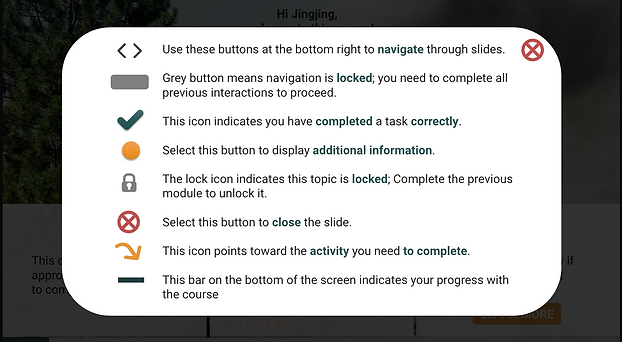Jingjing Bao
PROTECTING YOUR HOME FROM WILDFIRE
This course employs a variety of interactive activities to educate learners about wildfire risks associated with their homes and the steps they can take to protect them.
Target audience: home owners in Washoe County, Nevada
Tools used: Articulate Storyline, Adobe Illustrator
Development time: 20 hours
Context
This project idea originated from my work at the National Center for Disaster Preparedness (NCDP), where I worked on FEMA-funded trainings. When I first joined the NCDP instructional design team, I was asked to create a Storyline project to demonstrate my Storyline skill. I chose to develop a short course on protecting home from wildfires, a topic of great interest to me since I live in a wildfire-prone area. This e-learning course is based on a FEMA guideline on protecting properties from wildfires. I translated the PDF document into an interactive learning.
Design Rationale
Relevant Learning
According to adult learning principles, adults learn best when they see the relevance of the content to their lives and work. I designed this e-learning course based on this principle.
The target audience for the course is the house owners of Washoe County, where I live. Therefore, instead of presenting general information about wildfire risk, I included the information about wildfire risk that is most relevant to Washoe County residents. Learners can find out the wildfire risk of their properties by selecting the city they live in on the Washoe County map included in the course (see below).

Active Learning
The design of this course is also based on the adult learning principle that adults learn best when they are actively involved in the learning process, rather than being passive recipients of information.
The course includes a variety of interactive activities to engage learners and give them the opportunity to learn by doing.


Immediate Application
Another adult learning principle that this course is based on is that adults are more likely to retain and apply what they learn when they can immediately apply it to their lives and work.
This course includes activities where learners can type and download the next steps that they can apply immediately after learning.

Scaffolding
Scaffolding is important in teaching to help learners learn effectively and efficiently. The design of this course provides sufficient support for any cognitively stressful activity that asks learners to evaluate their own homes and formulate actions to protect against wildfires.
For example, before learners are asked to think about how to improve their home landscape, a simulated home landscape improvement is provided to help learners recognize wildfire hazards around a home. Before asking learners to create a personal wildfire emergency checklist, a list of items that are highly recommended for emergencies is provided so learners have a reference.

Design with Empathy
Progress Bar
The design of this course takes into account the needs of different learners. For example, when going through e-learning, some learners may want to know how far along they are in their learning. In this course, learners can get to know where they are in their learning from the customized course menu and the progress bar displayed at the bottom of the screen.

Navigation Guidance
This course provides navigation instructions for learners who are unfamiliar with e-learning features and provides guidance when learners get stuck.



Accessibility Mode
This course provides an accessibility mode for the activity that some learners may have difficulties to complete.

